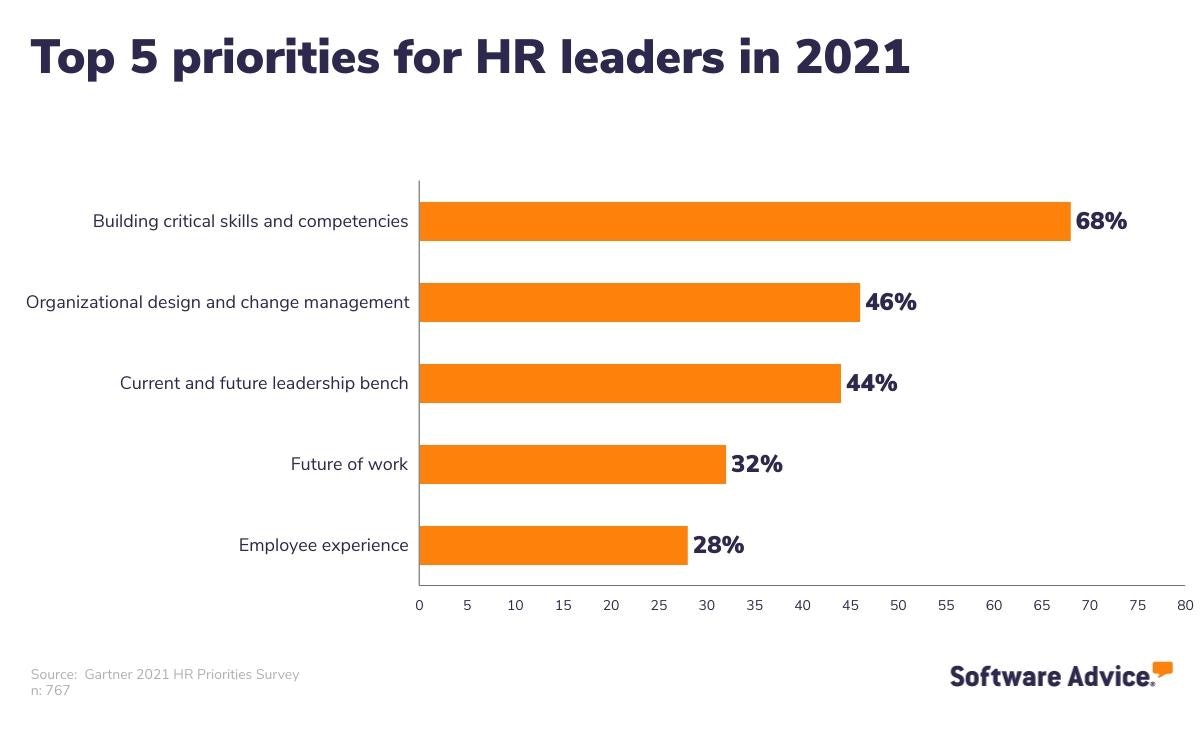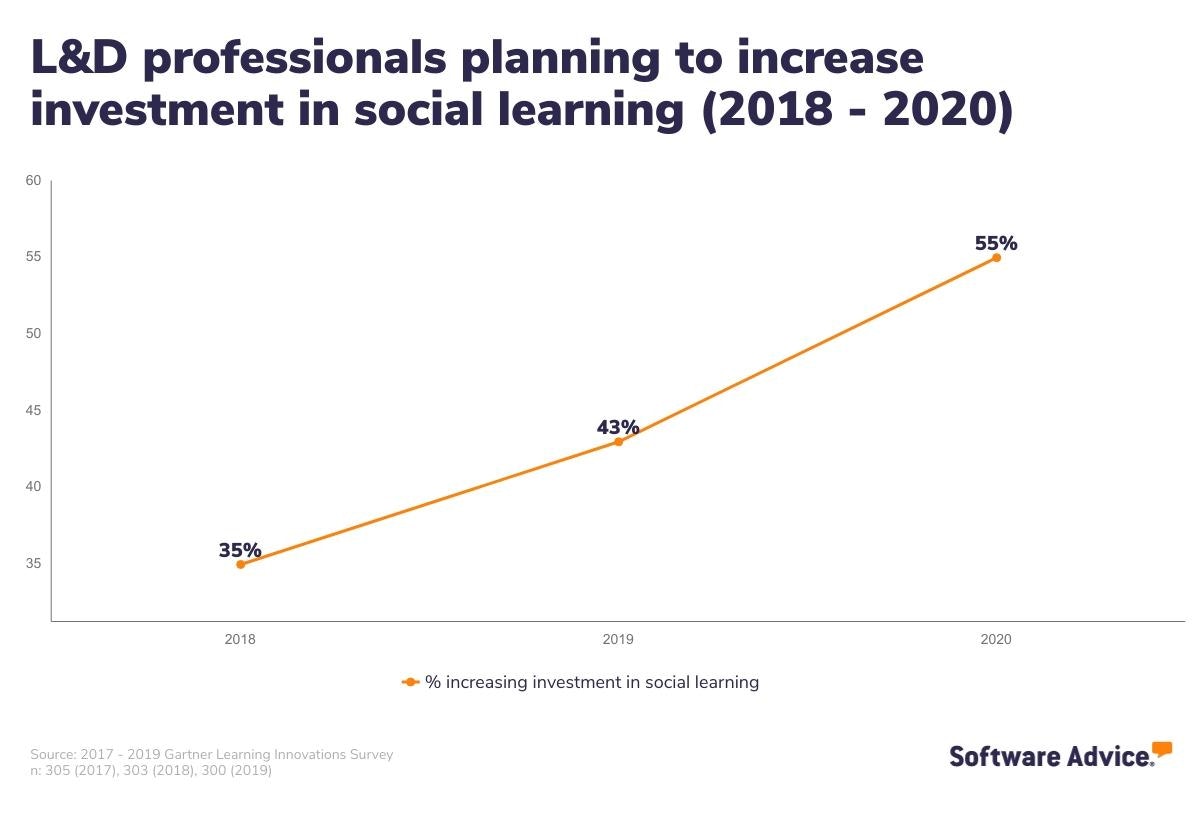5 E-Learning Trends Shaping the Future of Training
With some companies forced to pivot to remote work on the fly, and many more having to make drastic changes to keep employees and customers safe, learning and development (L&D) took an unexpected (but understandable) backseat last year. In a Software Advice survey of small business employees, nearly half (49%) told us they haven’t developed any new skills during the pandemic.
Unsurprisingly, companies are eager to play catch-up with L&D: According to Gartner, HR leaders rank building critical skills and competencies as their top priority in the year ahead (full research available to Gartner clients):

If you’re reading this, you recognize how important workplace learning is to maintain a competitive and engaged workforce. To that end, what are the e-learning trends that we’ll all be talking about this year?
In this article, we’ll look at five e-learning trends we believe are shaping the future of employee training. Below, we’ll explain what these trends are, why they’re trending, and—most importantly—how your business can take advantage of them this year.
Trend #1: Learning experience platforms (LEPs) will modernize your LMS
As great as learning management systems (LMS) are for tracking and administering e-learning, the experience of using them as a learner can sometimes be underwhelming.
Brittany Walther, our own software advisor team manager here at Software Advice has talked to hundreds of organizations about software options. She explains that with many businesses working remotely or in a hybrid model, autonomous learning is crucial for employee self-development and work satisfaction, and this is where an LEP can come in handy:

“The main difference between LMS and LEP is the experience of the user. A traditional LMS focuses on training a user must complete, while an LEP allows the user more access content to drive their own path.”
Brittany Walther
Advisor Manager
Learning experience platforms (LEPs) are designed to work with your LMS, and have a number of intuitive features that help enhance the learner experience:
LEPs can display any format of e-learning content (podcasts, videos, articles, etc.) alongside fully-built e-learning courses in a Netflix-like interface that’s easy for browsing.
Content can be tagged and filtered by skills, career paths, or a variety of other ways. Learners also have the option to create their own tags and methods of organization.
AI can recommend the best e-learning content to learners based on the learning material they’ve consumed before, or what’s been rated highly by similar users.
According to Gartner, while only 46% of L&D professionals are currently using LEPs, a further 31% said they were planning to adopt LEPs in the near future—making it the learning channel with the greatest expected future use (full research available to Gartner clients).
How you can take advantage of this trend
Here are three tips for how you should approach adopting an LEP:
Survey and segment your learners: Discover your employees’ learning needs and preferences, then use that data to group your workers into distinct learning segments. For example, if you find your employees love podcasts, that can be a content area to focus on for your LEP.
Shortlist LEP vendors based on your current tech stack and skills needs: LEPs can be purchased standalone or bundled with an LMS. If you already have an LMS you like, consider the former; if not, the integrated bundle might be better.
Start small: Pilot your learning platform with a targeted group of learners for six to 12 months. Monitor the effect of the LEP on learning and business outcomes during this period and make adjustments as needed.
Trend #2: Social learning is the affordable training initiative you’ve been waiting for
Having spent on average $1,111 per learner on training last year, businesses are on the prowl for more cost-effective methods to help workers develop important skills. Social learning may be the answer, as it gives companies an affordable way to round out e-learning needs without having to develop or purchase new content from scratch.
Social learning uses technology to connect people together and facilitate knowledge sharing outside of formal employee training. Social learning includes things such as:
Mentorship programs: Managers and corporate trainers can analyze skills gaps and connect employees in mentorship relationships. Mentors can schedule mentorship activities, record notes, and track worker progress toward development goals.
Course discussions: Forums and social media-like feeds accompany e-learning courses to facilitate conversations and knowledge sharing.
Content creation tools: Employees have access to tools to write blogs, create videos, and develop other types of e-learning content to share with their coworkers.

How you can take advantage of this trend
If you currently have e-learning software with social learning features, use them! If your current training systems don’t offer social learning features, ask vendors if there is a timeline for them to be implemented. Even non-training platforms, such as collaboration software, can be used for knowledge sharing.
If you don’t have software, you can still facilitate social learning in your organization. Here are some tips:
Do an employee skills gap analysis: Using data from skills assessments and performance reviews, identify the biggest skills strengths and skills weaknesses on your team. Next, use this analysis to pair employees together in mentor-mentee relationships.
Set up a social learning protocol: Ensure there are resources that help direct your employees to the right peer or leader in your organization to develop their skills. Upload your protocol to the company intranet, and send out regular reminder emails about this resource.
Take advantage of current networks: Reach out to professionals in your work network to see what learning resources they can share. Some may even be open to creating e-learning content or leading a virtual training session with your employees.
Trend #3: Learning + performance will tell you if training is really having an impact
Learning + performance is the process of integrating employee training and performance management software systems and data. The benefits of this are tremendous: Workers can automatically receive personalized e-learning content based on areas of improvement, while managers can observe if training investments are actually improving employee performance.
Businesses are catching on to the benefits of learning + performance: According to Gartner, 43% of L&D professionals plan to integrate their LMS with their performance management systems—making it the highest planned future adoption rate of any LMS feature (full research available to Gartner clients). Additionally, software vendors are increasingly integrating learning and performance features in one system to provide more value to their clients.
How you can take advantage of this trend
If you don’t already have a talent management suite with tightly integrated learning and performance applications, learning + performance can be a real challenge when attempting to marry two separate systems together. Here are some tips to improve your odds of success:
Standardize performance ratings: If different teams are using different methods to evaluate performance, it’ll be difficult to translate that data into actionable insights. Work with HR and managers to establish a standard set of performance ratings and the factors that determine them.
Incorporate 360 feedback: Managers don’t always have the best vantage point to gauge employee performance. Incorporating 360 feedback from other sources can remove bias and deliver better learning outcomes.
Up your learning analytics game: Talk to your vendor about your options for tracking things such as engagement rate, time on course, bounce rate, and more.
Trend #4: Learning in the flow of work will deliver training when and where employees need it most
Translating what’s learned in a classroom or e-learning course to actual work is one of the top challenges of corporate training. Without a manager or mentor standing over an employee’s shoulder to immediately correct an action or offer advice, workers are on their own to take what they learn in training and apply it to their jobs.
That’s where learning in the flow of work comes in. Using AI, chatbots, and integrations with other systems, learning in the flow of work aims to send e-learning content about a skill to employees in real time on the job. Organizations that are effective at integrating learning into day-to-day work have a 61% higher likelihood of applying virtual learning (full research available to Gartner clients).
Here are some examples of learning in the flow of work:
Stressed about an upcoming cold call to a CEO, a sales rep sees e-learning content pop up in their customer relationship management (CRM) system with tips for communicating with CEOs
While writing a message to customers in their email marketing software, a chatbot tells an employee about a great new e-learning course on email marketing laws and best practices
Struggling to sort through mountains of data in their business intelligence tool, a manager sees a pop-up with a list of e-learning courses related to data organization and management
How you can take advantage of this trend
Implementing learning in the flow of work can be a challenging project to take on for any business. Here are some tips to make this initiative go more smoothly:
Ask vendors about existing e-learning partnerships: Your current software vendors may already have partnerships and integrations with e-learning providers to deliver learning in the flow of work.
Update your e-learning content tags: Chatbots and other forms of AI need data to be able to successfully deliver the right e-learning content in the flow of work. Talk to your e-learning vendors for help with content tagging options.
Start with something simple but widely applicable: The email system you use or your workplace collaboration tool is a great place to start delivering targeted e-learning content in the flow of work to reach the most employees.
Trend #5: Microcredentials will solve employee upskilling woes
Tailored to specific skills needs, and taking as little as a few weeks and a couple of dollars to earn, microcredentials offer a more agile and affordable approach to upskilling. Gartner predicts that by 2025, 30% of global organizations will use microcredentials to calibrate skills and reward upskilling to increase productivity (full research available to Gartner clients).
Here are a few advantages of microdentials for employers:
Managers can recommend microcredentials to their employees based on individual skill needs to alleviate company skills gaps
Game based learning functionalities, such as leaderboards, can be created to rank employees based on how many microcredentials they’ve earned
Companies can weigh microcredentials in hiring and promotion decisions to incentivize further earning of digital badges
How you can take advantage of this trend
Unless you’re Google or IBM, you probably don’t have the resources or clout to offer microcredentials of any merit on your own. That means you’ll have to partner with a reputable microcredential provider. Here are some things to keep in mind when researching different provider options:
Look for LMS and LEP integrations: Microcredential providers often partner with certain LMS and LEP vendors to keep everything centralized in one system. If you have an LMS or LEP already, prioritize providers that partner with your system.
Research each provider’s reputation in the business world: Microcredentials can be a great recruiting tool, so do some research to see which providers end up on job listings or are most sought out by job seekers. Your provider could help you attract top talent.
Ask about discounts: Instead of paying by the course, talk to providers about corporate subscription options to lower the cost of offering microcredentials significantly.
Get with the times: Reassess your e-learning software needs
You can’t take advantage of these e-learning trends without the right software. With hundreds of products available on the e-learning market, we know that the search for a corporate learning platform can be intimidating. But whether you’re looking for a small virtual classroom app or a comprehensive learning management system (LMS), Software Advice can help you find the perfect tool for your needs.
Our e-learning software advisors are standing by. Click here to chat with an advisor and tell them your feature needs and budget. They’ll then recommend five top-rated systems that best work for your unique criteria—all free of charge.
Survey methodology
The Capterra HR in the New Era Survey 2021 was conducted in January 2021. We surveyed workers at U.S. small businesses with two to 500 employees. The responses are a representative sample (by age and gender) of the U.S. population. We worded the questions to ensure that each respondent fully understood the meaning and the topic at hand.